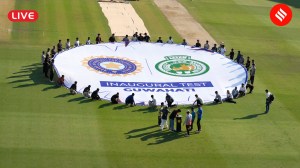A soldier is born in every family here
SHIRUR (PUNE DISTRICT), JULY 25: Babai Srirang Sangle has the faintest idea that her 21-year-old son Sepoy Kisan Sangle is in the midst o...

SHIRUR (PUNE DISTRICT), JULY 25: Babai Srirang Sangle has the faintest idea that her 21-year-old son Sepoy Kisan Sangle is in the midst of a battle at Kargil. She received a letter on Saturday from her son assuring her that he was well.
“Do not worry about me. I am okay. And don’t send any more letters to Udhampur. I have been transferred,” he says, without divulging any more details. Some sketchy letters from her son and the local sarpanch Bajirao Narayan Wakhare of Golegaon village at Shirur, located around 70 kms from Pune, remain her only source of information.
Golegaon has a unique tradition. Every family from this village of 1700 people has given a soldier to the nation. Grandfathers talk of the time when their fathers were with the Azad Hind Fauj. The tradition which firmly took roots with the World War II has so far given the nation as many as 172 soldiers. At present, more than 70 sons of Golegaon are with the Army and some of them are battling the enemy at Kargil, Drass and Batalik sectors.
Unlike Apshinge in Satara district where the tradition of sending sons to the military has been influenced by the unfriendly nature, the villagers at Golegaon have few worries. Many of them are educated. Almost every family in the village has two graduates. There have been two judges and five police sub-inspectors at one time in Golegaon. And there are others who could be traditional farmers, but have preferred to join the armed forces in the service of the nation.
Take the case of Jaisingh Vishnu Kolte who had fought the 1962 and the 1965 wars and died in an accident in the village. His family failed to receive any benefits from the government. But that did not deter his younger brother Dnyandev Vishnu Kolte from joining the Army.
Three generations of the Katke family have been with the Army. Paratrooper Vijay Katke who is the first to have attained the rank of a captain has spent seven years in the army. The last he came home was on June 16 for a hurried two-day visit. “He did not have much time and wrote a letter conveying that he is well,” his wife Shanta shyly remembers.
Subedar Major Hanumant Dhondiba Bhogwade’s family, however, is very proud of him. “Of course, we are worried. But I feel proud that my father is fighting the enemy at Kargil,” says his young daughter Anita presently studying for her TYBA. Younger brother Sachin is now raring to get into the army. He may do so next year.
However, all is not rosy at Golegaon. “Everybody remembers soldiers during times of war. They are forgotten during peace-time,” Sudam Kolte, chairman of the Jai Jawan Dudh Utpadak Sanstha bitterly complains. The Rs 18 lakh Krishnamai Sainik Lift Irrigation Scheme is yet to see the light of the day. For that matter, the higher secondary school begun at the initiative of the villagers closed down after a gap of two years due to lack of support from the government. “We spent Rs 5000 for three years in succession to obtain the government grant but nothing happened,” says sarpanch Wakhare. Children at Golegaon can only study up to Std VII at the local school. For higher studies, they have to trek atleast seven kilometres a day.
The Central Government came forward with a scheme to set up a guest house for ex-servicemen in Golegaon since the village boasted of the maximum number of Armymen. The rest-house today lies in a derelict condition since the construction was abandoned half-way through. The primary health centre (PHC) never began functioning. For medical treatment, villagers have little option but to rush to Shirur. Golegaon has lost more than 15 men during war. Yet, plans for a memorial at the village will perhaps never materialise for want of funds.
Still, there is very little bitterness amongst the villagers who accept these things as a matter of fate. They may have lost their sons to war. Young wives may not seen their husbands for months. But one thing remains clear. The tradition of dedicating sons in the service of the nation will continue.



- 01
- 02
- 03
- 04
- 05




























